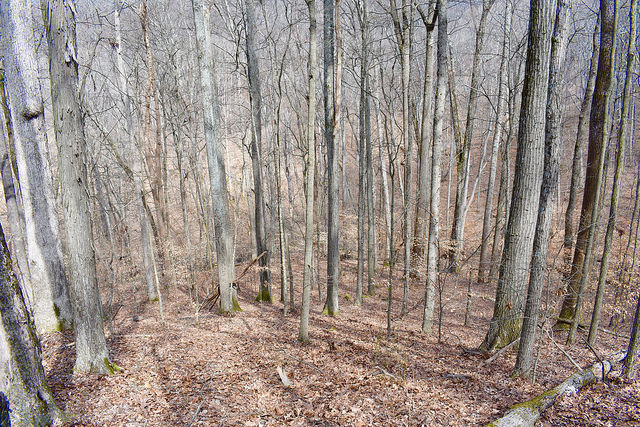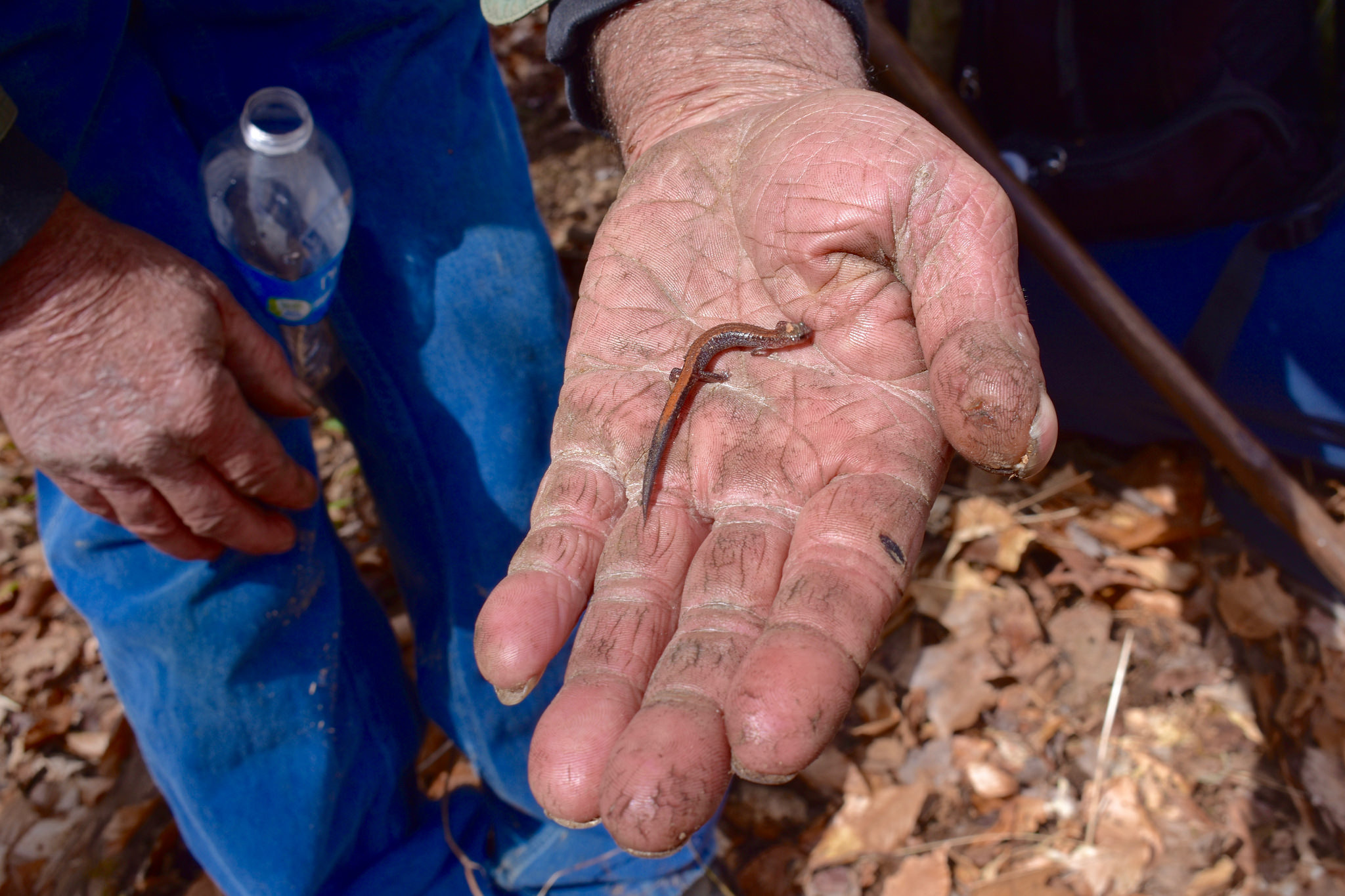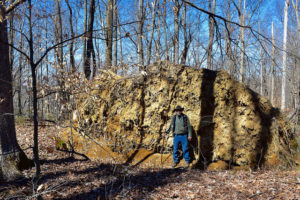We are making ourselves heard. Hundreds of Hoosiers — along with the Indy Star editors — have implored Governor Holcomb to reconsider a proposal by the Division of Forestry (DOF) in the Indiana Department of Natural Resources to log 299 acres in the Morgan-Monroe/Yellowwood State Forest Back Country Area (BCA).
This 2,700 acre BCA is the largest tract of old forest left in our state forests since logging was escalated by 400% over the last 12 years to restore 30% of the DOF’s budget cut by the Legislature. The oldest trees in this tract are 130 to 160 years old.
There are so many reasons why this cut should be halted. These are just a few that Governor Holcomb should heed:
 In July 1981, when this Back Country Area (BCA) was established, the head of the DNR said in press release: “We’re extremely pleased to provide this new area for persons who enjoy the rugged, primitive areas remaining in Indiana. A subsequent brochure published by the Division of Forestry (DOF) explained that logging in the BCA will be restricted to single tree selection of mature, damaged or diseased trees on slopes of less than 45 degrees to allow this area to be enjoyed by the wilderness seeker as a place of solitude and repose. This cut will make the forest a place you don’t want to be.
In July 1981, when this Back Country Area (BCA) was established, the head of the DNR said in press release: “We’re extremely pleased to provide this new area for persons who enjoy the rugged, primitive areas remaining in Indiana. A subsequent brochure published by the Division of Forestry (DOF) explained that logging in the BCA will be restricted to single tree selection of mature, damaged or diseased trees on slopes of less than 45 degrees to allow this area to be enjoyed by the wilderness seeker as a place of solitude and repose. This cut will make the forest a place you don’t want to be.
Unlike previous harvests which were smaller and out of public view in the northwest and southeast corners of the BCA, this plan will log 299 acres located across most of the center of the Back Country Area. It will require two popular hiking trails, the Tecumseh Trail and Possum Trot Trail, and the primary entry point into the BCA’s eastern side to be closed for six months.
The plan is proposing to log a higher volume from this area than was proposed to be logged over comparable sized areas in at least 12 of 30 other selective cut logging operations outside of the Back Country Area in Yellowwood State Forest since 2013. It will harvest between 475,000 and 712,800 board feet from the 299 acres, taking approximately 23%, nearly a fourth of the standing tree volume from more than half the acres, damaging many remaining trees, tearing up the ground on steep slopes, and leaving stumps, gravel roads and many other very visible impacts for many years.
State forests are the only state public lands where wilderness recreation long distance hiking, back packing, primitive camping, orienteering, hunting and foraging in wild nature is possible in Indiana. These activities are not possible in state parks, nature preserves, or fish and wildlife areas. As such, the state forests, particularly the three Back Country Areas established in them, are crucial assets that enhance Indiana’s quality of place. The Regional Cities study emphasized that the talented workers companies are looking for most, educated younger workers — and those workers are deciding where to live based on many variables but among the top are certainly recreation amenities, one of which is trails.
Indiana’s business community is recognizing that attracting a talented work force necessary to attract new high paying employers requires a focus on quality of place. Indiana’s ecological crown jewel are our beautiful native hardwood forests. BENCHMARKING U.S. REGIONAL CITIES: A STUDY AND GUIDE FOR TRANSFORMATION Interim Report produced by the Indiana Economic Development Corporation to launch Indiana’s Regional Cities Initiative in 2014 finds that cities and regional communities across the nation are successfully transforming and growing their economies by focusing on quality of place which includes recreational amenities such as trails and public lands that allow people to get close to nature.

On the other hand, the state’s timber industry would hardly notice if logging in the three BCAs in our state forests was forgone to conserve their wilderness for recreation. At 158,000 acres, Indiana’s entire state forest system comprises just 3.2% of the state’s 4,900,000 total forested acres.
In turn the Morgan-Monroe/Yellowwood Back Country Area’s 2,700 acres comprise just 1.7% of the state forests’ acreage. The 3 BCAs collectively comprise 7,200 acres, just 4.6% of the state forests’ total acreage. Today’s harvests from all state forests of 14 million board feet make up just 5-6% of the total board feet harvested in Indiana annually according to the Purdue University’s Annual Timber Price/Stumpage Reports.
IFA’s biologist surveys over the past 4 years have found that 21 endangered species including the Indiana bat, timber rattlesnake, smokey shrew, and worm-eating warbler live in this forest.
Lastly, these forests are our heritage. As IFA member, seventh-generation Hoosier Angela Herrmann, put it: “I’ve had the good fortune of traveling around the world. Of all of the places I?ve ever visited, no place has ever felt more like home to me than southern Indiana, specifically the area known as Yellowwood Forest with its aromas of spring flowers, summer campfires, and autumn decay. The silence I experience on a winter’s day within Yellowwood forest is unlike any silence I have ever experienced anywhere else. Destroying these woodlands is akin to removing any connection my family and I might ever have to our ancestral history. These are the forests my ancestors would have traveled through and hunted in as they migrated north from Kentucky. A forest like this cannot be replaced in my lifetime.”
If you’ve called the Governor and made official comments to the Division of Forestry, what more can you do
1) Keep writing to the Governor. Be creative!
2) E-mail DNR Director Cameron Clark.
3) Ask your state rep and senator to ask the Governor to stop the timber sale.
4) Ask your friends and neighbors to do items 1-3.
5) Write a letter to the editor of your local paper.
It’s time that the Governor put the Division Forestry in check. A tidal wave of sustained public pressure is the way that this timber sale will be stopped. THANK YOU for speaking out!

